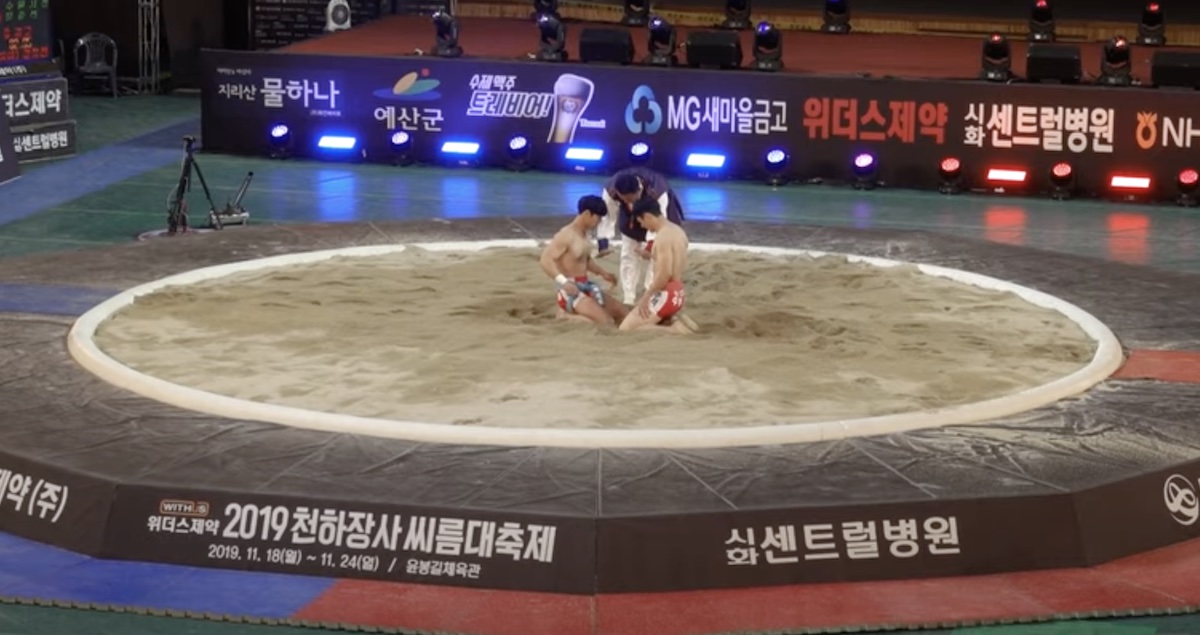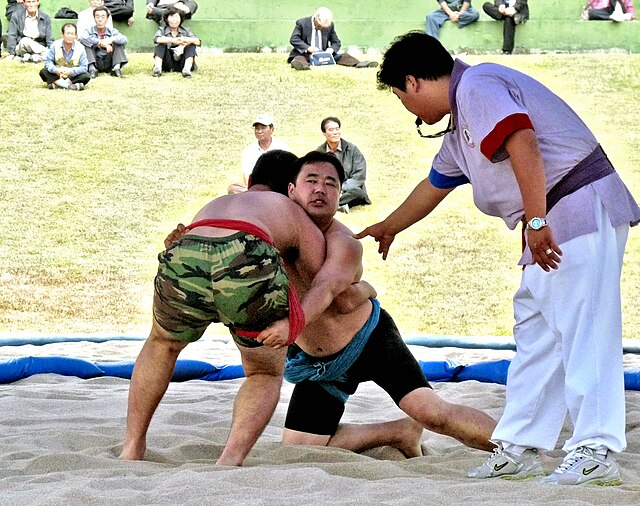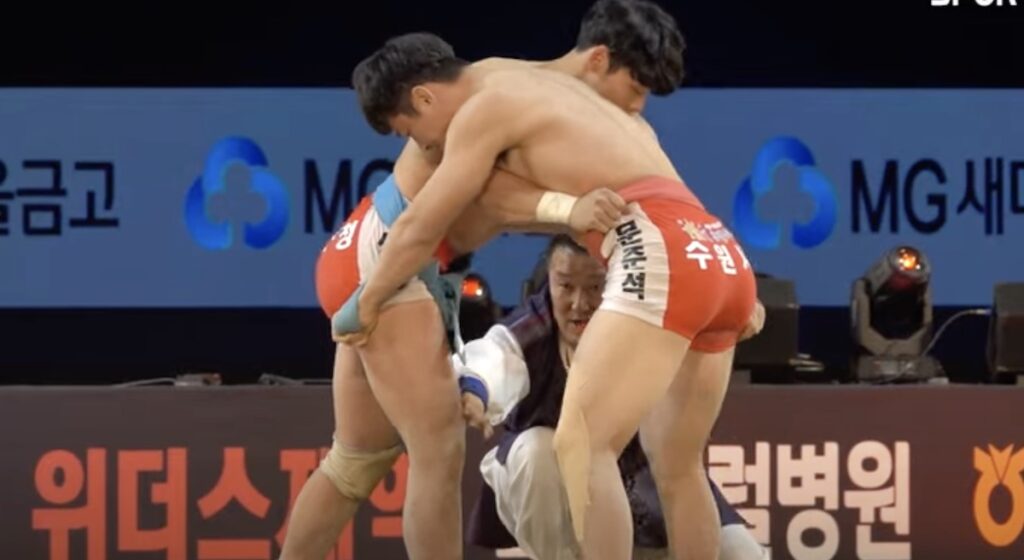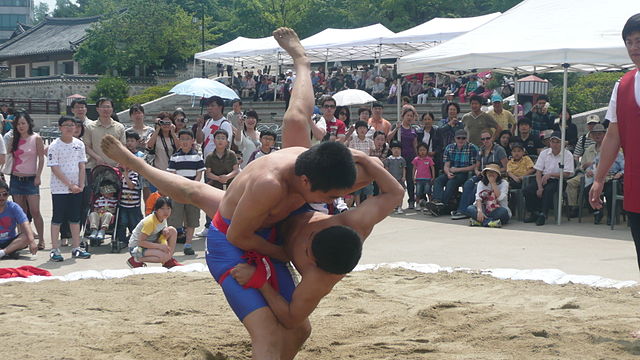Ssireum: Korean Wrestling

When people talk about Korean martial arts, the obvious one that gets said is Taekwondo. But the Korean wrestling style of ssireum is also rather popular and predates Taekwondo by centuries.
Here is what you need to know about the Korean wrestling style known as ssireum. Going over its long history and the format of this style of wrestling.
What is Ssireum?
Ssireum or Korean wrestling is a folk style of wrestling that has been practiced within the country for centuries. The grappling art is also known as “hangul” and is one of the oldest forms of Korean martial arts.
This style of wrestling dates back to the Goguryeo period. It originated in military hand to hand training and gradually became a popular past-time.
Even as the Goguryeo period ended, ssireum wrestling would continue through the Goryeo and Joseon periods. It would become a tradition for this sport to be held during the Korean holiday known as Dano. The fifth day of the fifth lunar month.
Ssireum events would also be held on various other Korean holidays. Such as the Third Day of the Third Moon and the Buddhist holiday of All Souls Day.
Originally, the winners of the competition would receive a prized bull from the king.

Modern Ssireum
During the early 20th century, this form of Korean wrestling would grow into a more widely practiced grappling art. The first modern hangul wrestling competition was held in 1912 at the Dansonga Theater in Seoul.
During the 1920s, organizers began referring to the wrestling style as ssireum. Along with the name change, the Pan Chosun Ssireum Federation was founded in 1927.
After Japan lost WW2 and the occupation of Korea, Korean wrestling was really able to expand. The National Ssireum Championship Contest was first held in 1947 and is still the biggest wrestling competition in South Korea.
During the twelve national championship events, weight divisions were added. Giving chances to wrestling of various sizes and making for more competitive matches.
Today, ssireum is more popular than ever and is nationally televised within South Korea. Also instead of a bull, the winners of the national tournament are awarded a giant gold plated bull statue.
The Format
The rules and format of ssireum wrestling can vary slightly depending on the specific event or competition. Here are the general rules and format of a traditional ssireum competition.
Rings and Boundaries
Ssireum matches take place in a circular sand ring called a “jjjangjangi.” A ring consisting of sand and dirt that has a diameter of seven meters. The ring is marked with boundary lines and the goal is to force your opponent over the lines or take them down.
Wrestling Attire
Wrestlers are only permitted to wear two pieces of clothing which are wrestling shorts and the satba sash. The satba sash is worn around the waist and was added during the mid 20th century.
It was added as the original form of this style of wrestling also included a similar piece of attire. Federation heads wanted to add it to pay homage to the roots and culture of this form of wrestling.
Starting Position
When the two wrestlers meet in the center of the ring, they start by getting on their knees. Then each competitor grabs the other’s satba and waits for the main judge’s signal to go.
Ssireum Techniques
The techniques used in this martial art consists of throws, trips, and pushes. Using a mixture of these techniques to either take their opponent down or push them past the boundary lines.
Illegal Moves
Wrestlers are only permitted to try techniques above their opponent’s waist or using their satba. No strikes of any kinds or submissions are allowed in a match.
Out of Bounds
If any part of a wrestler’s body touches past the out of bounds markers, their opponent is awarded a point. The match is then restarted in the middle in the neutral position.
Ways to Win
All forms of ssireum wrestling go by a two out of three falls format. The first wrestler to earn points is declared the winner of the match.
Tournament Format
Most of the main tournaments go by a round robin style format. Whoever goes unbeaten in their weight division is declared the winner of the tournament.

The Weight Classes of Ssireum
When weight classes were first introduced in 1967, the governing body made four different weight classes. All four of which were named after mountains within South Korea.
| Weight Class | Lb | Kg |
| Taebak (Flyweight) | 176 lb | 80kg |
| Geumgang (Lightweight) | 198 lb | 90 kg |
| Halla (Middleweight) | 231 lb | 105 kg |
| Baekdu (Heavyweight) | Under 352 lb | Under 160kg |
The Training in Ssireum
The training in Ssireum is much similar to the formats of other more practiced styles of wrestling. Practice sessions are hours of grueling technical training followed by free wrestling matches.
Then much like freestyle wrestling or Greco Roman, ssireum wrestlers have hard strength and conditioning programs. Doing various types of weight training, running, and mixing in circuit training to get in top shape for competitions.

Wrestling Styles That Share Similarities
When you watch a Ssireum wrestling match, this Korean wrestling style shares similarities to other more known grappling styles. Particularly the wrestling styles of Greco Roman style wrestling and the art of sumo.
Just like in Greco Roman wrestling, you are only allowed to use technique from the hips up in Korean wrestling. Then like in Sumo, ssireum wrestlers are allowed to grab the satba sash to control and take an opponent down.
There is also a hint of beach wrestling in this grappling style since matches take place within a sand circle.
The Global Expansion of Ssireum
In the past twenty years, this style of Korean wrestling has gradually expanded globally. There are now numerous ssireum wrestlers across Europe and Asia. The world championship has been held in various places from Germany, Lithuania, Myanmar, and of course South Korea.
Ssireum has also had the honor of being inscribed into the UNESCO Intangible Cultural Heritage Lists. Becoming listed as the 131st Intangible Cultural Property.






